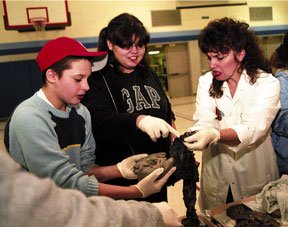After lunch one day during her eighth grade year, Kathy Ketchum sneaked outside her Lake Stevens Middle School to have a cigarette.
A smoker for almost a year at that point, Ketchum couldn’t wait to get that first puff after a morning of class. She was shaking and a little sick. She needed a smoke.
When she went back to class, her hometown doctor was waiting for her and the rest of the class. He was there to convince them to avoid cigarettes or, if they were already smoking, to quit. Ketchum said she wasn’t much interested in what the doctor had to say — until he pulled out a pair of smoke damaged lungs from a human cadaver.
“And I stopped smoking that day,” said a much older Ketchum last Wednesday as she spoke to a health class at Langley Middle School.
A nurse at Providence Medical Center in Everett, Ketchum now does much the same show her doctor did when she was a kid. Called “The Real Inside Story,” Ketchum’s brings not only lungs, but human livers, hearts and a brain to accompany stories and lessons intended to steer teenagers away from cigarettes, alcohol, marijuana and other harmful behaviors.
The show, which Ketchum put on for more than 160 schools and dozens of shiploads of Navy sailors last year, has impact. Now in her 14th year with “The Inside Story” — which is sponsored by Providence — Ketchum knows how to get students’ attention. Speaking quickly in the LMS multipurpose room, she described how cigarette smoke destroys lung tissue, how chewing tobacco is manufactured to contain plutonium, and what really happens to a human brain in a car crash.
Pulling towels off the cadaver organs she brought as visual aids, Ketchum showed students the difference between compact, healthy human lungs and those distended and blackened by cigarette smoke. Then she pulled out a half-dozen livers, one healthy and flexible, the others hard as hockey pucks due to alcohol-induced cirrhosis and hepatitis. Lastly, there was a heart punctured by a bullet one friend shot into another while playing with a gun he though was unloaded.
“These people all chose their own deaths,” Ketchum said, waving a hand over the table.
Highest on her list of killers were tobacco products, and she made that clear to the full day’s worth of classes she spoke to at LMS. While it was the smoke and carbon monoxide from cigarettes that did the most visible damage to her cadaver lungs, she said the nicotine they delivered was as potent a killer. Used in rat poison and other pest killers, pure nicotine is toxic to humans. A single concentrated drop of the chemical is enough to kill a person.
While some students seemed a bit restless during Ketchum’s talk, everyone perked up when it came time to put on rubber gloves and handle the organs. Just before lunch, seventh grader Jorge Flores pushed the “eeeeew” factor to the limit as he poked and pulled at a few pairs of lungs. Cindy Howard’s ickiest moment came when she gently lifted a human brain out of a plastic bucket. She hefted it for only a few seconds, not trusting herself to avoid plunging a finger into the organ’s cottage-cheese-like consistency.
Howard was one of a few students at Ketchum’s presentation who have already seen the harmful effects of smoking up close. She said she watched her stepfather die of lung cancer a few years ago.
“That’s just one of the reasons I don’t smoke,” she said.
Providence Medical Center pays the full cost of sending “Inside Story” to schools like Langley Middle School. The presentation debuted on South Whidbey last year at Bayview High School.



